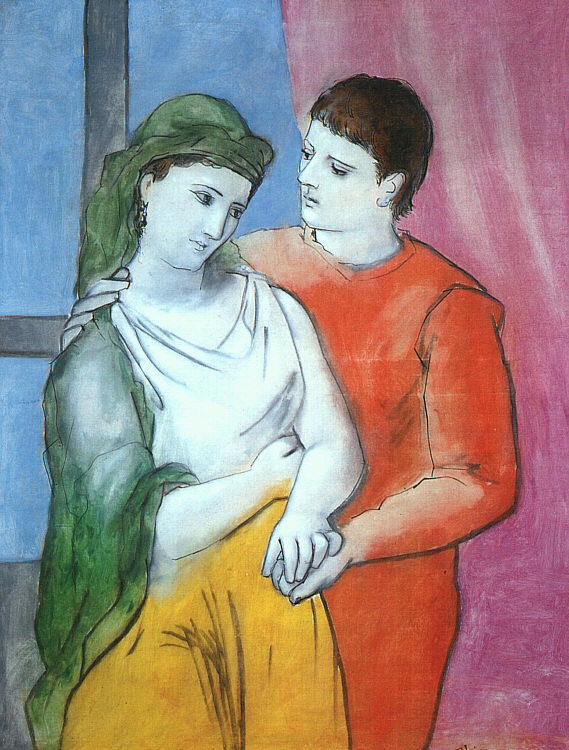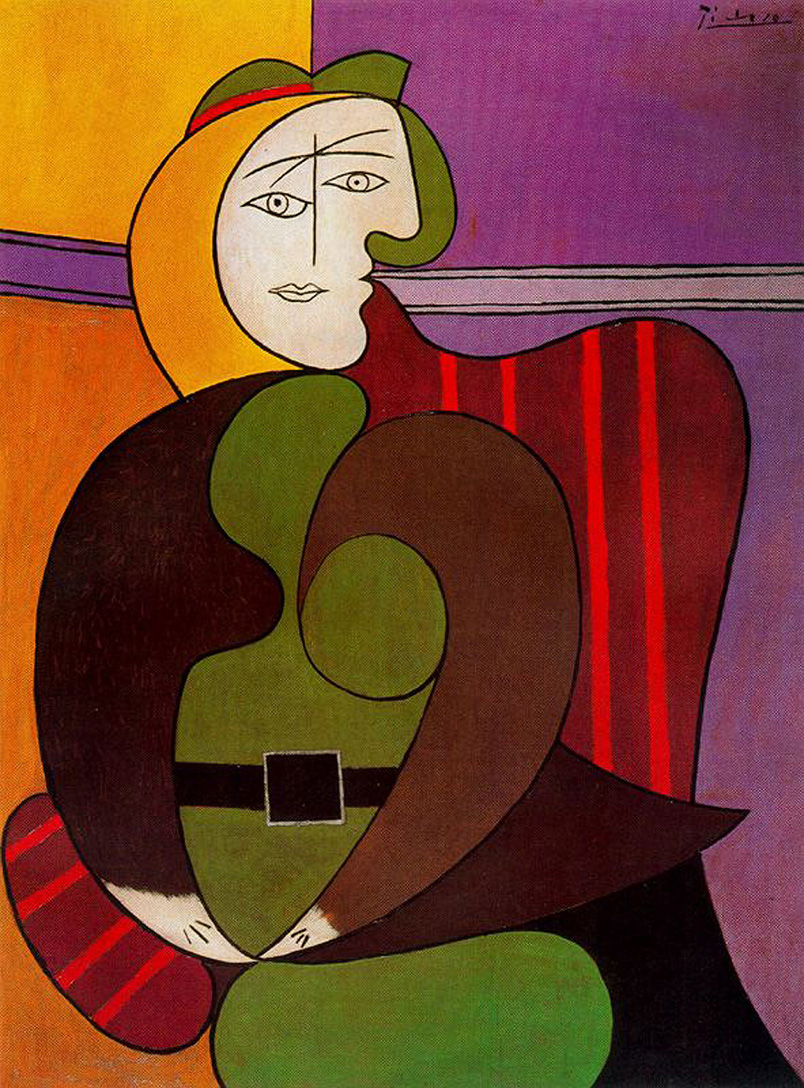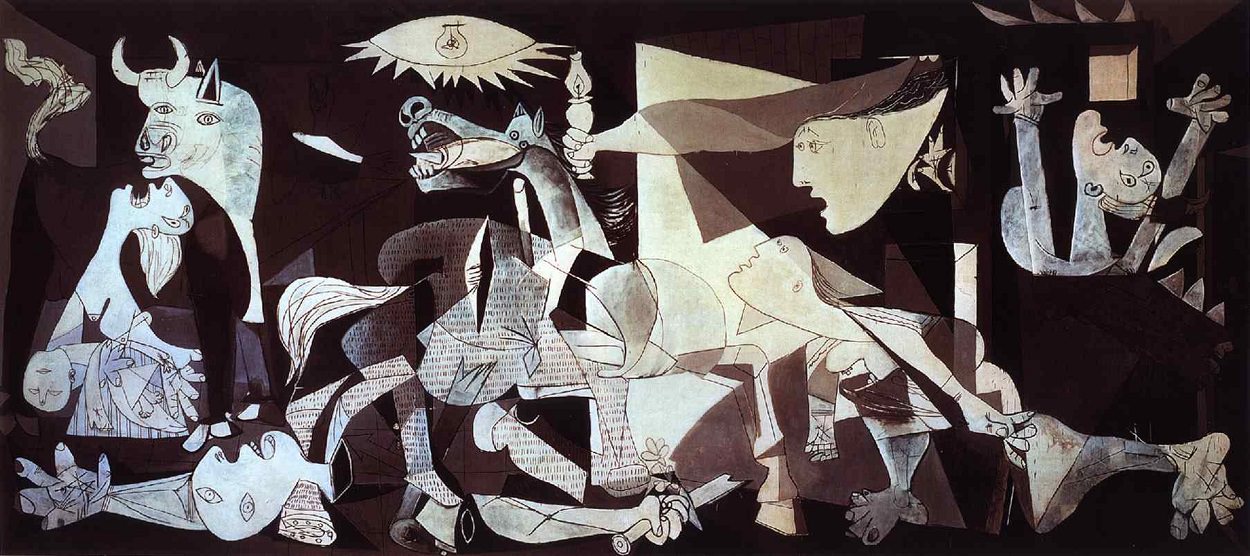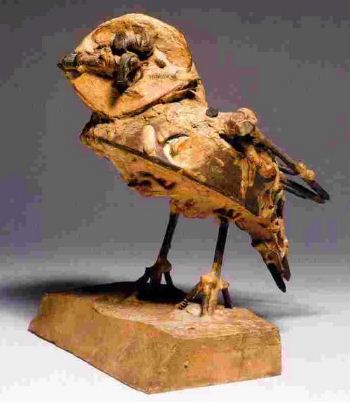 Pablo Picasso was a Spanish painter, sculptor, printmaker, ceramicist, stage designer, poet and playwright who spent most of his adult life in France.
Pablo Picasso was a Spanish painter, sculptor, printmaker, ceramicist, stage designer, poet and playwright who spent most of his adult life in France.
Born: October 25, 1881, Málaga, Spain
Died: April 8, 1973, Mougins, France
Pablo Picasso was born on October 25, 1881, in Málaga, Spain. The son of an academic painter, José Ruiz Blanco, he began to draw at an early age. In 1895, the family moved to Barcelona, and Picasso studied there at La Lonja, the academy of fine arts. His visit to Horta de Ebro from 1898 to 1899 and his association with the group at the café Els Quatre Gats about 1899 were crucial to his early artistic development. In 1900, Picasso’s first exhibition took place in Barcelona, and that fall he went to Paris for the first of several stays during the early years of the century. Picasso settled in Paris in April 1904, and soon his circle of friends included Guillaume Apollinaire, Max Jacob, Gertrude and Leo Stein, as well as two dealers, Ambroise Vollard and Berthe Weill. His style developed from the Blue Period (1901–04) to the Rose Period (1905) to the pivotal work Les Demoiselles d’Avignon (1907), and the subsequent evolution of Cubism [more] from an Analytic phase (ca. 1908–11), through its Synthetic phase (beginning in 1912–13).
Picasso’s collaboration on ballet and theatrical productions began in 1916. Soon thereafter, his work was characterized by neoclassicism and a renewed interest in drawing and figural representation. In the 1920s, the artist and his wife, Olga (whom he had married in 1918), continued to live in Paris, to travel frequently, and to spend their summers at the beach. From 1925 into the 1930s, Picasso was involved to a certain degree with the Surrealists, and from the fall of 1931 he was especially interested in making sculpture. In 1932, with large exhibitions at the Galeries Georges Petit, Paris, and the Kunsthaus Zürich, and the publication of the first volume of Christian Zervos’s catalogue raisonné, Picasso’s fame increased markedly.
By 1936, the Spanish Civil War had profoundly affected Picasso, the expression of which culminated in his painting Guernica (1937, Museo Nacional Centro de Arte Reina Sofia, Madrid). Picasso’s association with the Communist Party began in 1944. From the late 1940s, he lived in the South of France. Among the enormous number of Picasso exhibitions that were held during the artist’s lifetime, those at the Museum of Modern Art, New York, in 1939 and the Musée des Arts Décoratifs, Paris, in 1955 were most significant. In 1961, the artist married Jacqueline Roque, and they moved to Mougins. There Picasso continued his prolific work in painting, drawing, prints, ceramics, and sculpture until his death April 8, 1973.


The Blue Room
I am describing Pablo Picasso’s painting called “Blue Room.” This picture is about a bedroom that has somber tones and a woman bathing. It looks sad. I like it because of its color. Although the picture looks dark, for me it seems peaceful and relaxing.
“Blue Room” is one of Picasso’s paintings in the Blue Period. This period is quite sentimental. At that time Picasso’s paintings were depressing with somber tones because he was going through a hard time as result of his friend’s suicide. He was in his late teens, away from home, and very poor.
In this picture we can appreciate a bedroom with a blue background and a woman standing on the floor taking a bath. There is a bed with a white blanket. Above the bed there is a beautiful doll. Next to it there is a little picture, and on the other side a book bag. In front of the bed there is a big window, and under the window there is a brown chest. Next to the bed there is a table with a beautiful flowers. The floor has some red and green tones. Even though the painting looks sad and dark, I like it because it is a nice bedroom. I like the way it is adorned, and the color blue is a sign of peace for me.
–Analia Velasquez
In this painting, I can see a woman naked alone in the room. She’s bending and wiping her body. There is a portrait, a picture, flower, a vase, bed, table. The back ground color is blue.
When I saw the Blue Room of Pablo Picasso, I felt free, weird and I was going from comfort to chaos. Painting has various meanings, and I could guess the point of that.
Actually Picasso had a mental disease. Maybe he might want to express his inside by the picture. I suppose The Blue Room is his mind space.
To be honest, when I was alone in my room, I felt free but very lonely, empty- and I traveled inside of myself. I looked for myself, the reflected ego like the naked women in the picture. Can’t we make our the Blue Room like Picasso?
Through that, I could remind myself, and guess Picasso’s meanings. Isn’t that the power of art?
Why don’t you make a room of your own color?
Chang Hun Song
The blue period of his life was from 1901-1904 when he was 22 years old. He painted everything in blue. He painted in blue a sign of sadness from when his best friend died. All of these paintings had sad or lonely expressions on their faces. Some people thought it ‘Was fabulous and others thought it was crazy.
After his move to Paris in 1904, Picasso’s rose period paintings took on a warmer more optimistic mood. The rose period was another period in his life. This was right after the blue period. That period went from 1904-1906. He started to paint in brighter colors. He drew people doing happy things. He also drew lots of circus scenes with circus animals in this period. In 1907 he and French painter George Braque pioneered cubism.
Cubism was another period in his life. He started this style of his when he was only 26 years old. The pictures were cube shaped abstract figures. A famous painting in cubism he drew w called “Tete de Feme
Picasso painted many dramatic pictures during World War I and after the Spanish Civil War. He painted them to show how stupid he thought the war was. Some of them were huge like “GuemicEC’ (twelve feet high and twenty-five feet wide) that he named after the town he lived in during the war.
By 1912 Picasso was incorporating newspaper print, postage stamps and other materials into his paintings. This style is called collage. By the late 1920s he turned toward a flat, cubist-related style. During the 1930s his paintings became militant and political. Guernica (1937), a masterpiece from this period depicts the terror of the bombing of the town of Guernica during the Spanish civil war.
Following World War II, Picasso’s work became less political and more gentle. He spent the remaining years of his life in an exploration various historical styles of art, making several reproductions of the work of earlier artists.








Guernica is a painting by Pablo Picasso. It was created in response to the bombing of Guernica, a Basque Country village in northern Spain, by German and Italian warplanes at the behest of the Spanish Nationalist forces on 26 April 1937 during the Spanish Civil War.
Guernica is a statement against fascism, showing the tragedies of war and the suffering it inflicts upon individuals, particularly innocent civilians. This work has gained a monumental status, becoming a perpetual reminder of the tragedies of war, an anti-war symbol, and an embodiment of peace. Upon completion, Guernica was displayed around the world in a brief tour, becoming famous and widely acclaimed. This tour helped bring the Spanish Civil War to the world’s attention.
Guernica is grey, black and white, 3.5 meters high and 7.8 meters wide, a mural-size canvas painted in oil.
Guernica shows suffering people, animals, and buildings wrenched by violence and chaos.
- The overall scene is within a room where, at an open end on the left, a wide-eyed bull stands over a woman grieving over a dead child in her arms.
- The centre is occupied by a horse falling in agony as it had just been run through by a spear or javelin. The large gaping wound in the horse’s side is a major focus of the painting.
- Two “hidden” images formed by the horse appear in Guernica:
- A human skull overlays the horse’s body.
- A bull appears to gore the horse from underneath. The bull’s head is formed mainly by the horse’s entire front leg which has the knee on the ground. The leg’s knee cap forms the head’s nose. A horn appears within the horse’s breast.
- The bull’s tail forms the image of a flame with smoke rising from it, seemingly appearing in a window created by the lighter shade of gray surrounding it.
- Under the horse is a dead, apparently dismembered soldier; his hand on a severed arm still grasps a shattered sword from which a flower grows.
- On the open palm of the dead soldier is a stigma, a symbol of martyrdom derived from the stigmata of Christ.
- A light bulb blazes in the shape of an evil eye over the suffering horse’s head (the bare bulb of the torturer’s cell). Picasso’s intended symbolism in regards to this object is related to the Spanish word for lightbulb; “bombilla”, which is similar to the word “bomba” for bomb in Spanish.
- To the upper right of the horse, a frightened female figure, who seems to be witnessing the scenes before her, appears to have floated into the room through a window. Her arm, also floating in, carries a flame-lit lamp. The lamp is positioned very close to the bulb, and is a symbol of hope, clashing with the lightbulb.
- From the right, an awe-struck woman staggers towards the center below the floating female figure. She looks up blankly into the blazing light bulb.
- Daggers that suggest screaming replace the tongues of the bull, grieving woman, and horse.
- A dove, holding an olive branch is scribed on the wall behind the bull. Part of its body comprises a crack in the wall through which bright light (hope, or the outside world) can be seen.
- On the far right, a figure with arms raised in terror is entrapped by fire from above and below. The right hand of the man suggests the shape of an airplane.
- A dark wall with an open door defines the right end of the mural.


La petite chouette was on display at the Art Basel 2000 where the gallery sold it for about CHF1 to 1.5 million. The sculpture belongs to Picasso’s assemblages which he began in the early 1940s when he came across an old bicycle saddle and a rusty pair of handlebars on a scrap heap. He immediately put them in his mind to a bull’s head and later executed his vision. His assemblages were a combining of ready-made, sought out objects to form a work of art. Picasso’s objective was on no account to rationally produce a dramatic effect, but to create an object from a spontaneous decision, which expressed his feelings at that particular moment. With La petite chouette Picasso went one step further. He had the idea of creating a sculpture of an owl and scoured rubbish bins and scrap yards, searching for suitable materials. He made his owl entirely from pieces of scrap he had found, including nails, screws, nuts, a pair of pliers and a metal saucepan, which, however, have lost their original appearance but have been skillfully joined together with plaster to give rise to a “realistic” likeness of an owl.
PICASSO EXHIBITED IN PARIS:
On June 24, 1901, the first major exhibition of Pablo Picasso’s artwork opens at a gallery on Paris’ rue Lafitte, a street known for its prestigious art galleries. The precocious 19-year-old Spaniard was at the time a relative unknown outside Barcelona, but he had already produced hundreds of paintings. The 75 works displayed at Picasso’s first Paris exhibition offered moody, representational paintings by a young artist with obvious talent.
Pablo Picasso, widely acknowledged as the dominant figure in 20th-century art, was born in Mýlaga, Spain, in 1881. His father was a professor of drawing and bred Picasso for a career in academic art. He had his first exhibit at age 13 and later quit art school so he could experiment full-time with modern art styles. He went to Paris for the first time in 1900, and in 1901 he returned with 100 of his paintings, aiming to win an exhibition. He was introduced to Ambroise Vollard, a dealer who had sponsored Paul Cýzanne, and Vollard immediately agreed to a show at his gallery after seeing the paintings. From street scenes to landscapes, prostitutes to society ladies, Picasso’s subjects were diverse, and the young artist received a favorable review from the few Paris art critics who saw the show. He stayed in Paris for the rest of the year and later returned to Paris to settle permanently.
The work of Picasso, which comprises more than 50,000 paintings, drawings, engravings, sculptures, and ceramics produced over 80 years, is described in a series of overlapping periods. His first notable period–the “blue period”–began shortly after his first Paris exhibit. In works such as The Old Guitarist (1903), Picasso painted in blue tones to evoke the melancholy world of the poor. The blue period was followed by the “rose period,” in which he often depicted circus scenes, and then by Picasso’s early work in sculpture. In 1907, Picasso painted the groundbreaking work Les Demoiselles d’Avignon, which, with its fragmented and distorted representation of the human form, broke from previous European art. Les Demoiselles d’Avignon demonstrated the influence on Picasso of both African mask art and Paul Cýzanne and is seen as a forerunner of the Cubist movement founded by Picasso and the French painter Georges Braque in 1909.
In Cubism, which is divided in two phases, analytical and synthetic, Picasso and Braque established the modern principle that artwork need not represent reality to have artistic value. Major Cubist works by Picasso included his costumes and sets for Sergey Diaghilev’s Ballets Russes (1917) and The Three Musicians (1921). Picasso and Braque’s Cubist experiments also resulted in the invention of several new artistic techniques, including collage.
After Cubism, Picasso explored classical and Mediterranean themes, and images of violence and anguish increasingly appeared in his work. In 1937, this trend culminated in the masterpiece Guernica, a monumental work that evoked the horror and suffering endured by the Basque town of Guernica when it was destroyed by German war planes during the Spanish Civil War. Picasso remained in Paris during the Nazi occupation but was fervently opposed to fascism and after the war joined the French Communist Party.
Picasso’s work after World War II is less studied than his earlier creations, but he continued to work feverishly and enjoyed commercial and critical success. He produced fantastical works, experimented with ceramics, and painted variations on the works of other masters in the history of art. Known for his intense gaze and domineering personality, he had a series of intense and overlapping love affairs in his lifetime.
Quotations
“The artist is a receptacle for emotions that come from all over the place: from the sky, from the earth, from a scrap of paper, from a passing shape”. Pablo Picasso
“There are painters who transform the sun to a yellow spot, but there are others who with the help of their art and their intelligence, transform a yellow spot into the sun.” Pablo Picasso
“My mother said to me, ‘If you become a soldier you’ll be a general; if you become a monk you’ll end up as the pope.’ Instead, I became a painter and wound up as Picasso.”Pablo Picasso
“Every child is an artist. The problem is how to remain an artist once he grows up.” Pablo Picasso
“Everything you can imagine is real”. Pablo Picasso
“I am always doing that which I can not do, in order that I may learn how to do it.” Pablo Picasso
“It is your work in life that is the ultimate seduction.” Pablo Picasso
“Painting is just another way of keeping a diary”. Pablo Picasso
